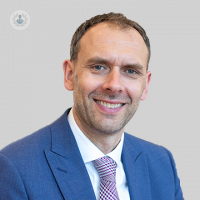Constant pain in your hip? Femoroacetabular impingement explained
Autore:If you have hip pain that simply won’t go away, femoroacetabular impingement (FAI) is one possible cause. In this article we interviewed leading consultant trauma and orthopaedic surgeon Mr Nick de Roeck to find out what causes FAI, how it can be diagnosed and how it is treated.

What is femoroacetabular impingement (FAI)?
Femoroacetabular Impingement (FAI) is a condition that can lead to non-resolving pain arising from the hip joint. It occurs more commonly, although not exclusively, in younger adults and those participating in sports. The pain is most commonly felt deep in the hip or groin but can be perceived in the thigh or knee.
Initially, FAI can present with pain after exercise that will recover with rest. However, as the condition progresses and the pain worsens it can prevent participation in sport and ultimately become constant in nature. Some patients develop a stiff joint, start to limp and even get disturbed sleep.
How does FAI happen?
It’s important to start by understanding that the hip is a ball and socket joint. The femoral head (ball) sits inside the acetabulum (socket). The ball and socket are covered in articular cartilage which allows the joint to move smoothly. The socket is ringed by the acetabular labrum, a cartilage ring which helps provide extra stability to the joint.
In FAI, abnormal bony lumps, or spurs, form during adolescent growth. These can arise on the femoral head, (CAM lesion), or around the hip socket (PINCER lesion). Some patients have a combination of both. These spurs can abut against each other and over time lead to damage to the acetabular labrum and joint cartilage. If the damage progresses, it may lead to osteoarthritis and a permanently painful, stiff joint.
The condition is not caused by sport, but it is thought the repeated impact arising from certain activities can hasten the presentation. Not all patients with the bony spurs develop symptoms, but the reasons for this are not yet fully understood.
How is FAI diagnosed?
Diagnosis of FAI can usually be made by an experienced hip surgeon on the basis of the patient’s history and a clinical examination. It is confirmed with the use of x-rays and often an MRI or CT scan. Sometimes an injection is put into the joint as a confirmatory test.
How is FAI treated?
The pain can be helped by rest and non-steroidal anti-inflammatory drugs (NSAIDs). In some cases, patients can minimise the symptoms by avoiding the activities that cause the pain. Physiotherapy can help some patients by means of muscle strengthening and activity advice.
If these measures are unsuccessful then surgery can be performed. This is now usually performed arthroscopically; in other words by putting a small camera into the joint and operating through keyholes. The aim of the surgery is to remove the underlying bony spurs and address the damage to the cartilage.
If you are worried about hip pain and would like to book a consultation, click here to see Mr Nick de Roeck’s availability.



